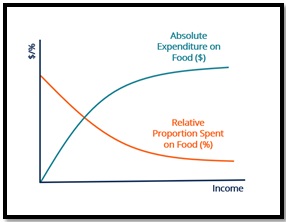INDIANS SPENDING MORE ON MILK, FRUITS AND VEG THAN FOODGRAINS:
Why in the news?
- The latest Household Consumption Expenditure Survey (HCES) reveals a continuous decline in the portion of total spending allocated to food items among Indians.
- This shift in spending pattern is evident from a reduction in the share of foodgrains and sugar, with a notable increase in expenditure on animal and horticulture products.
source:slideserve
About Rising Expenditure on Nutrient-Rich Foods:
- The data from the HCES highlights a significant increase in spending on milk, fruits, and vegetables, surpassing the expenditure on staple food items.
- Additionally, there is a growing preference for eggs, fish, and meat, indicating a shift towards animal proteins over plant-based proteins.
| What is an Engel curve?
● Engel Curve hypothesis, indicating higher incomes lead to a smaller food expenditure proportion. ● Emphasis on nutrient-rich foods highlights the need for policy interventions in agricultural production. ● Promotion of dairy, poultry, and horticulture crops recommended over traditional foodgrains incentivized by MSP. What is CES? ● CES stands for Consumer Expenditure Survey. ● It is conducted every five years by the National Statistical Office (NSO). ● The survey aims to gather data on household consumption expenditure to understand consumption patterns and economic trends. |





